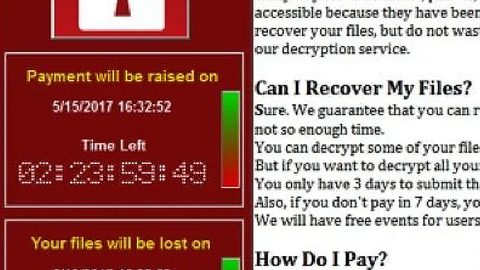What is Explorer ransomware? And how does it execute its attack on your computer?
Explorer ransomware is another file-encrypting virus created using the open source platform, HiddenTear. Like other ransomware infections, it is designed to take your files captive in exchange for ransom money. Security analysts first observed Explorer ransomware in the second week of July 2017.
To execute its attack, it sends out an infected file attached to spam email messages. And if you made the mistake of downloading and opening the malicious file, explorer.exe, it starts to execute its attack by connecting to its remote server. After that, it scans your computer for important files to encrypt. It encrypts them using a strong cipher (AES) that would be hard to decrypt unless you have the decryption key which is of course stored away by the crooks. It appends .explorer extension to each targeted files and then drops its ransom note in a file named READ_IT.txt containing the following message:
“Attention,!!!
All Your Documents ,Photos ,Databases And Other Impotant Personal Files Were Encrypted By A Strong Algorithm With Unique Key
To Restore Your Files, Contact Us With Email Address:
[email protected]
NOTE: If you Email Us in less than 24 hours, you will be paying half the regular price.
Explorer V1.58”
It urges you to write to [email protected] but it does not mention how much the ransom money is, usually, such infections demands amount ranging from $200-$1000 in Bitcoins. The crooks claim that if you don’t contact them within 24 hours, you’ll have to pay half the regular amount of the ransom. Keep in mind that no matter how desperate you are, you shouldn’t think about contacting these crooks for you might be getting yourself into even more trouble than you already are. It would be a lot better if you remove the ransomware and recover your files by following the instructions provided later on this article.
How does Explorer ransomware spread its infection?
Like mentioned earlier, Explorer ransomware spreads through malicious spam emails sent to random email addresses. The infected files attached are either a malicious executable file named explorer.exe or a macro-enabled document. These emails are disguised as something like an invoice, receipt and other documents that would trigger your curiosity. To prevent Explorer ransomware and other related information, follow these tips:
- Immediately delete any suspicious emails and don’t let any eye-catching subjects to convince you to open or worse download its attachment.
- Make sure that you always keep both your operating system and antivirus program updated since outdated system and antivirus can be easily exploited.
- Avoid visiting suspicious websites or downloading software from them.
- Always create a copy or two of important files to different storage location.
Terminate Explorer ransomware and its malicious files with the help of the following removal guide.
Step 1: Open Windows Task Manager by pressing Ctrl + Shift + Esc at the same time.

Step 2: Go to both the Application and Processes tabs and look for any suspicious applications and processes and then kill them.

Step 3: Open Control Panel by pressing the Windows key + R, then type in appwiz.cpl and then click OK or press Enter.

Step 4: Look for Explorer ransomware or any suspicious program and then Uninstall.

Step 5: Hold down Windows + E keys simultaneously to open File Explorer.
Step 6: Go to the directories listed below and delete everything suspicous in it. Or other directories you might have saved the zip file of Explorer ransomware.
- %TEMP%
- %APPDATA%
- %USERPROFILE%\Downloads
- %USERPROFILE%\Desktop
Step 7: Look for the ransom note; READ_IT.txt, the malicious file; explorer.exe as well as other malicious files created by Explorer ransomware.
The next step below is not recommended for you if you don’t know how to navigate the Registry Editor. Making registry changes can highly impact your computer. So it is highly advised to use PC Cleaner Pro instead to get rid of the entries that Explorer ransomware created. So if you are not familiar with the Windows Registry skip to Step 12 onwards.

However, if you are well-versed in making registry adjustments, then you can proceed to step 8.
Step 8: Open the Registry Editor, to do so, tap Win + R and type in regedit and then press enter.
Step 9: Navigate to the path below:
HKEY_CURRENT_USER\Software\Microsoft\Windows\CurrentVersion\Run
Step 10: Look for suspicious registry entries and delete them.
Step 11: Close the Registry Editor.
Step 12: Empty the Recycle Bin.
Follow the continued advanced steps below to ensure the removal of the ransomware infection:
Perform a full system scan using SpyRemover Pro.
- Turn on your computer. If it’s already on, you have to reboot
- After that, the BIOS screen will be displayed, but if Windows pops up instead, reboot your computer and try again. Once you’re on the BIOS screen, repeat pressing F8, by doing so the Advanced Option shows up.
- To navigate the Advanced Option use the arrow keys and select Safe Mode with Networking then hit
- Windows will now load the Safe Mode with Networking.
- Press and hold both R key and Windows key.
- If done correctly, the Windows Run Box will show up.
- Type in explorer http://www.fixmypcfree.com/install/spyremoverpro
A single space must be in between explorer and http. Click OK. - A dialog box will be displayed by Internet Explorer. Click Run to begin downloading SpyRemover Pro. Installation will start automatically once download is done.
- Click OK to launch SpyRemover Pro.
- Run SpyRemover Pro and perform a full system scan.
- After all the infections are identified, click REMOVE ALL.
- Register SpyRemover Pro to protect your computer from future threats.

















